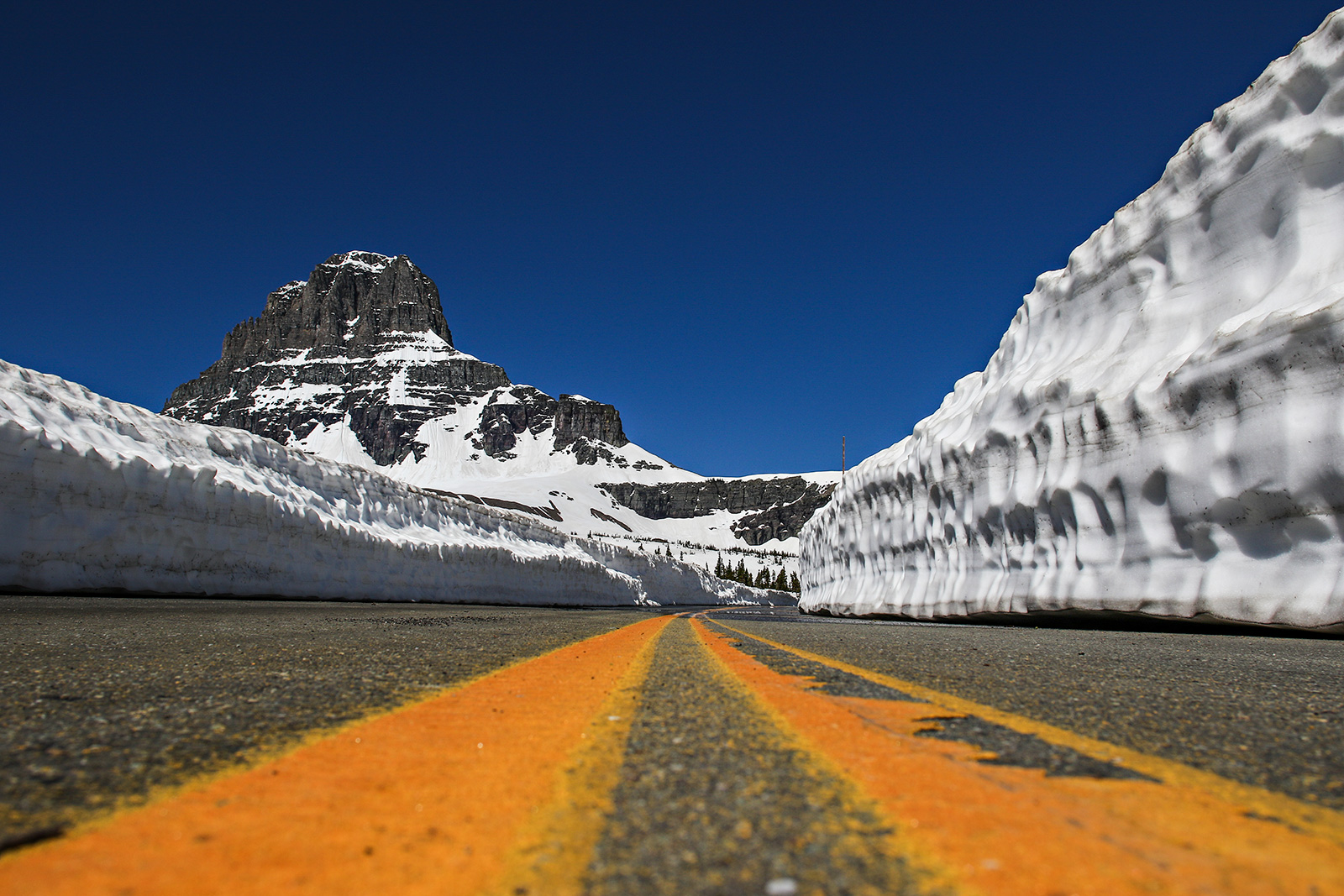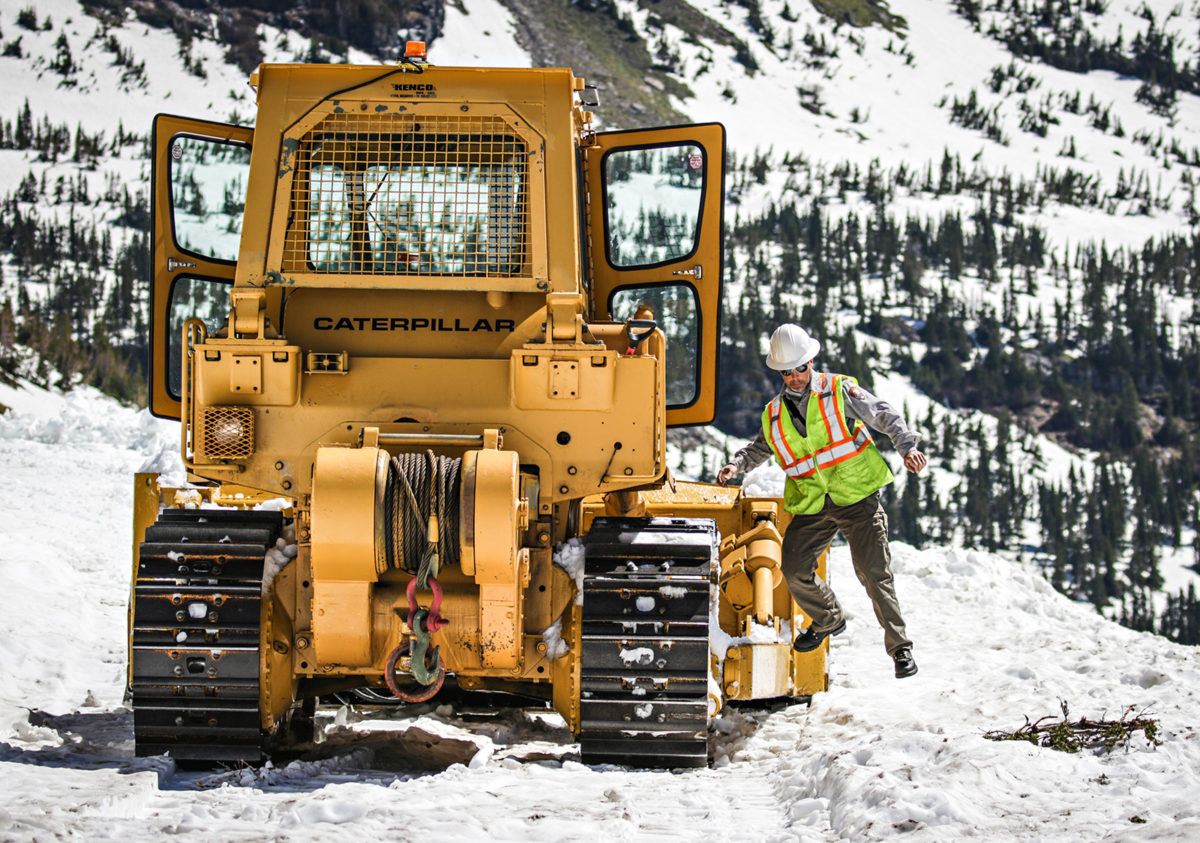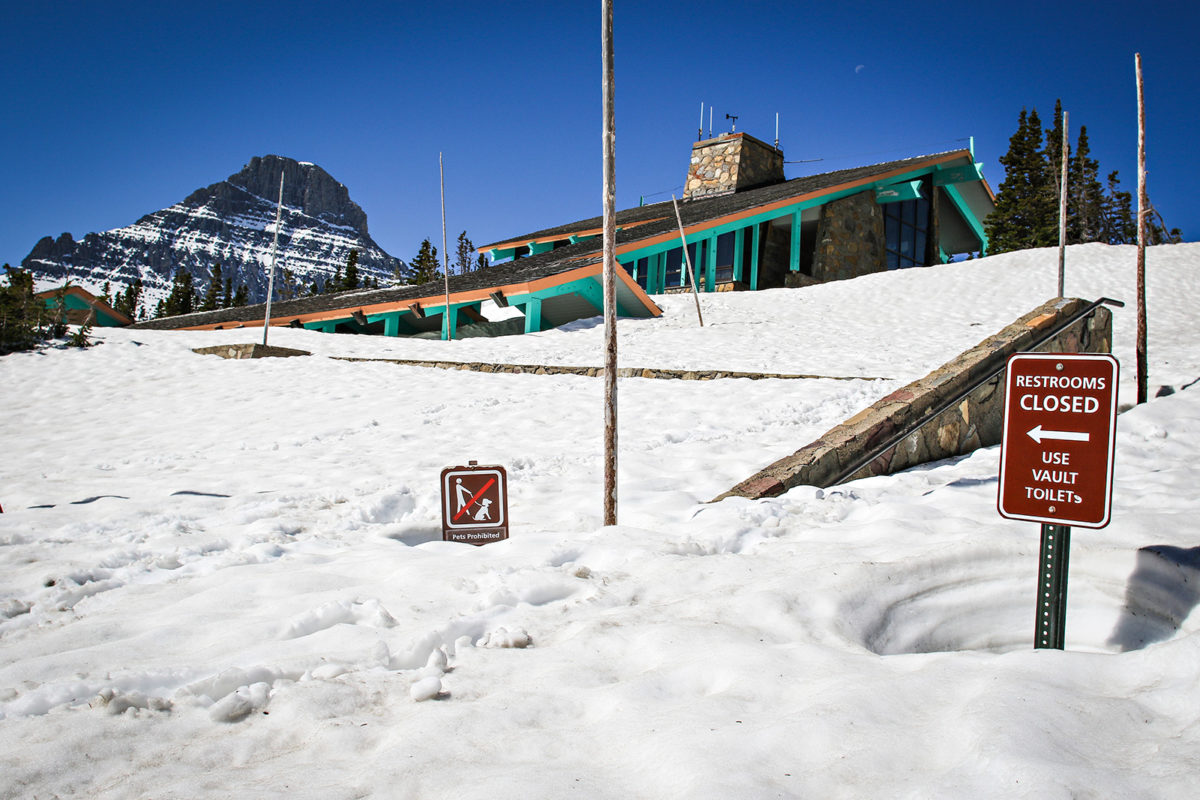
A Monumental Task
Every year plowing crews battle deep snow and inclement weather in order to prepare Going-to-the-Sun Road for summer crowds
Since 1933, Glacier National Park has been the site of one of the most extraordinary road maintenance tasks every spring. Park staff and contractors spend weeks, if not months, clearing the iconic Going-to-the-Sun Road of a winter’s worth of snow.
The Sun Road is a 50-mile byway that runs up and over the Continental Divide, crossing through the heart of Glacier Park. It is the only thoroughfare in the park, and conducts most of the parks three million annual visitors up to popular hiking trails at the 6,647-foot high Logan Pass.
For visitors to take their cars, ride the iconic red tour buses or cycle along the narrow road however, crews must remove more than six months worth of snow from the alpine sections of pavement.
Plowing the road is a monumental challenge that routinely requires crews to relocate snowdrifts dozens of feet high, and can be further compounded by unpredictable spring snowstorms.
The earliest plowing efforts date back to 1929, when the Sun Road was first opened to Logan Pass on the west side. The park received funds to purchase a 3/4-yard gasoline shovel, which was used for three weeks for snow removal in order to have the road open by June 15, according to the Cultural Landscape Report. That year, a crew of six men worked 10-hour shifts. In 1933, the year the road was officially dedicated, the crews worked the gasoline shovel in double shifts in order to clear the snow and slides in time for the targeted June 15 opening, removing approximately 15,000 cubic yards of snow and encountering drifts of snow 30 feet high.
While the technology has significantly improved in the intervening century, it still takes roughly three months to get the road ready for the summer season.
This spring, the annual rite began the first week of April, after crews cleared Camas Road. According to Glacier Park Road Supervisor Brian Paul, progress this year is moving more swiftly than in some recent years.
“Every year it changes completely,” Paul said on May 5, when the plowing crews were just clearing Big Bend. “You can go back to 2011, where we were just reaching Haystack Creek at this point, or this year where it’s been quicker just due to low snow conditions at the lower elevations. We made up a lot of time there.”
Anticipation of the iconic highway’s seasonal opening to the public is a spring refrain, and local residents guess aloud at the date they might be able to drive the full length of the Sun Road. Some years, the work is completed in May; others, not until mid-July.
Paul has been part of the road crew since 2009, and says it’s nearly impossible to establish a consistent timeline for the work with snowpack varying widely from year to year.

In the 88 years since its dedication, Going-to-the-Sun Road has opened between May 16 and July 15. The earliest opening was in 1987, and the latest was the inaugural year. The second latest opening date, July 13, occurred in 2011 and 2020, when limitations from COVID kept crews from their normal work conditions.
The average (“There’s really no average,” Paul said) opening day can be roughly pegged at June 10-11, although that is trending later — the average opening date (excluding 2020) has been June 17 since 2000, and June 21 since 2011. The last May opening date was in 2005.
While crews and Park staff can look at snow conditions during the plowing process to make rough estimates on when the road will be fully open, they don’t share predictions with the public.
“It’ll be ready for the public when it’s ready for the public,” Paul said.

During heavy snow years, or around some of the deepest drifts along the road, progress can be a slow as a quarter mile a week. Logan Pass has been known to lie dormant under up to 80 feet of snow during the winter, and the Big Drift, a one-mile stretch just east of the pass, is typically one of the largest accumulations on the road.
On the west side of the Park, a 12 person crew, which includes two USGS avalanche technicians and a heavy mechanic utilize excavators, front –end loaders and dump truck that can move thousands of tons of snow an hour.
Typically, the crew will start with the dozer to cut down the snowpack until it’s around four feet off the road, a height that the rotary snow plows can handle. For the deepest drifts, large excavators and bobcats are put to work. Equipment operators have to navigate the historic rock walls on the side of the raod and protect the guardrails, so once a path is clear, much of the residual snow on the edges of the road melts out naturally.
The avalanche technicians are a key part of the team, as avalanche chutes dot the road and are routinely triggered as the weather warms.
Every morning, weather forecasters check overnight temperatures, examine the snowpack and head up along the Garden Wall to dig snow pits and monitor conditions above the crews. The technicians monitor the snowpack along the high, snow laden slopes of the Garden Wall by utilizing data form remote sensors, weather stations and occasionally by helicopter. Any hint of snowpack loosening up and increasing avalanche danger will end work for a day.
“In 2011, we went through one section seven times because of repeated avalanches,” Paul said. “This year, we’ve already gone over some parts three times.”
Since avalanches are common along the road during the spring, hikers and bikers, who are allowed on the road once the plowing crews begin work, are usually told to stop at the Loop to minimize danger.
On May 13 of this year, three bikers who had ridden past the Loop to Triple Arches turned back after finding an avalanche field blocking the road, and encountered an active avalanche on their ride down, trapping two bikers for several hours before conditions were safe enough for rescue efforts.
“The sudden onset of sunny and warm weather… combined with recent new snow from the previous weekend created unstable surface snow conditions,” USGS scientist Erich Peitzsch said in a Park press release about the incident.
A similar incident in 2019 stranded 13 cyclists on the road above an avalanche for eight hours. Park officials say that one or two incidents a year where visitors end up in such situations is not uncommon.
The park works with the USGS to study avalanche risk every day before the crews get to work. Avalanche forecasters monitor the high, snow laden slopes of the Garden Wall using remote sensing, weather stations and in person observations.
Paul says that crews become closely knit after working together over the years.
“They put a lot of trust in each other, and they have to because a lot of opening the road situational awareness and mitigating risks and hazards,” Paul said.
Before taking over as manager, Paul used to operate heavy machinery, which involves being perched on the edge of the Sun Road’s cliffs for weeks at a time.
“It can get unnerving — I’d say it’s not a good job if you’re afraid of heights,” Paul said. “It puts you on edge and can make you real nervous, but once you’ve done it for a while you get confident in your abilities and in the snowpack.”
The best part, however, is being among the first people allowed into the heart of Glacier Park every year.
“Anytime you get beyond the gate and you’re the first one back there, it’s just so enjoyable,” Paul said. “It’s like you get to watch the park wake up in the springtime, just you and the animals.”